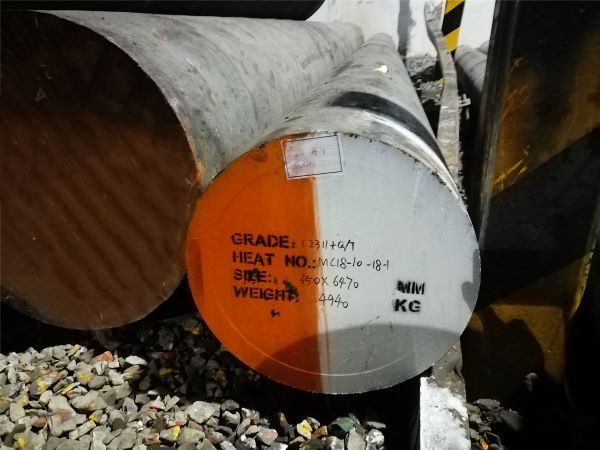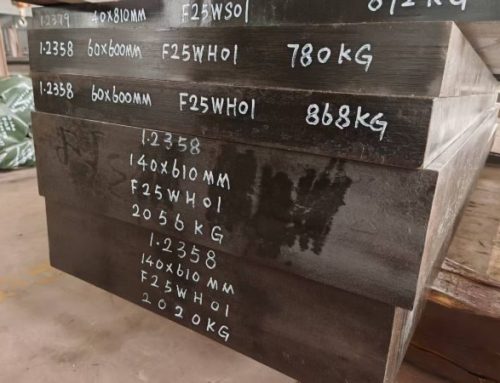As medium carbon chromium-molybdenum alloy steel, P20 steel is defined as P-Type,Plastic mold tool steel as per ASTM A681.
With its excellent comprehensive performance, excellent polishing, good etching performance and processing performance, good dimensional stability, convenience of pre-hardened state and good economic cost performance, P20 steel has become one of the preferred materials for manufacturing medium and large-sized, long-life, and high-surface quality plastic molds. P20 steel is worthy of being the well-deserved “main force” and “standard choice” in the plastic mold industry.

P20 steel is usually supplied in a pre-hardened state, which means that the steel mill has heat treated the steel (quenching + high temperature tempering) before leaving the factory to make it reach a certain hardness range (usually between 28-35 HRC). Users can directly perform mechanical processing (milling, turning, drilling, grinding, EDM, etc.) to manufacture molds, shortening the manufacturing cycle and avoiding heat treatment risks.
CHEMICAL COMPOSITION:P20 & EQUIVALENT GRADE
| Standard | Grade | C | Si | Mn | P | S | Cr | Mo |
| ASTM A681 | P20 | 0.28-0.4 | 0.2-0.8 | 0.6-1.0 | 0.03 | 0.03 | 1.4-2.0 | 0.3-0.55 |
| DIN ISO 4957 | 1.2311 | 0.35-0.45 | 0.2-0.4 | 1.3-1.6 | 0.03 | 0.03 | 1.8-2.1 | 0.15-0.25 |
| GB/T 1299 | 3Cr2Mo | 0.28-0.4 | 0.2-0.8 | 0.6-1.0 | 0.03 | 0.03 | 1.4-2.0 | 0.3-0.55 |
P20 steel Key performance characteristics:
- Good comprehensive mechanical properties: In the pre-hardened state (28-34 HRC), it has high strength, good toughness and moderate wear resistance, which can meet the strength and fatigue resistance requirements of most plastic molds.
- Excellent polishing performance: This is one of the most prominent advantages of P20 steel. Due to its uniform organization and high purity, after fine grinding and polishing, it can obtain a very high mirror finish, which meets the needs of transparent plastic parts and plastic products with high appearance requirements.
- Good etching (bite) performance: Its uniform structure also makes it very suitable for chemical etching or laser etching to obtain various leather grain effects.
- Good processing performance: In the pre-hardened state, its hardness is moderate and has good machinability (relative to tool steels with higher hardness). Free-cutting models (such as 1.2312) have better processing performance.
- Good nitriding performance: P20 steel is very suitable for surface nitriding treatment. After nitriding, a high hardness (up to 1000 HV or more), wear-resistant and corrosion-resistant nitrided layer can be formed on the mold surface, while the core still maintains good toughness, significantly improving the wear resistance and service life of the mold cavity.
- Good weldability (relatively speaking): Pre-hardened P20 steel can be welded and repaired, but measures such as preheating (300-400°C) and slow cooling after welding (preferably stress relief tempering) are required, and suitable mold-specific welding rods are selected to avoid cracks.
- Moderate corrosion resistance: Contains a certain amount of chromium, which makes it have a certain resistance to atmospheric and general plastic decomposition products. It is worse than ordinary carbon steel, but not as good as special stainless steel mold steel (such as 420, S136, etc.). For corrosive plastics such as PVC, surface treatment (such as chrome plating, nitriding) or stainless steel is usually required.
- Good dimensional stability: After good heat treatment (pre-hardening treatment), the structure is stable and the deformation after processing is relatively small.
P20 STEEL PHYSICAL PROPERTY
| Temperature | 20°C | 200°C |
| Density,kg/m3 | 7800 | 7750 |
| Modulus of elasticity,N/mm2 | 250000 | 200000 |
| Coefficient of thermal expansion,per °C from 20°C | — | 12.7 x 10 ^–6 |
| Thermal conductivity,W/mk | 29 | 29.5 |
| Specific heat,J/kg °C | 460 | — |
P20 STEEL FORGING
- Initial Forging Temperature:1050°C – 1100°,Maximum should not exceed 1150°C.
- Final Forging Temperature:850°C – 900°C. Forging below 850°C is absolutely not permitted!
- Forging Ratio:above 4:1
- Post-Forging Treatment:The cooling speed of P20 steel after forging must be slow! Recommended method: furnace cooling. After forging, stress relief annealing or full annealing must be performed.
P20 STEEL HEAT TREATMENT
- Stress Relieving
Since P20 steel involves further processing, in order to eliminate the adverse effects of processing stress, stress relief annealing is the most common subsequent heat treatment for P20 steel in the mold manufacturing process.
The stress relief annealing temperature of P20 steel is usually lower than the tempering temperature of pre-hardening to avoid reducing the hardness of the matrix. The recommended temperature range is 600°C – 650°C. The holding time is determined by the size and complexity of the workpiece, usually 1-2 hours/inch (25mm) section thickness, but at least not less than 2 hours. It must be furnace cooled to below about 300°C (preferably cooled to room temperature) and then air cooled out of the furnace. Slow cooling is key to prevent the introduction of new thermal stresses.
- Annealing
P20 steel is slowly heated to 760°C – 790°C (above the austenitizing temperature). After sufficient heat preservation, it is very slowly furnace cooled (cooling rate is controlled at < 20°C/hour) to below about 500°C, and then it can be taken out of the furnace and air-cooled.
Finally, P20 obtains a pearlite + ferrite structure close to equilibrium state, and the hardness is very low (≤ 22 HRC).
P20 Steel Mechanical property in Annealed condition
| Testing temperature | 200°C | 400°C | 500°C |
| Tensile strength Rm,N/mm2 | 860 | 780 | 610 |
| Yield strength Rp 0.2,N/mm2 | 640 | 570 | - |
| Elongation ,% | 17 | 18 | 26 |
| Reduction ,% | 55 | 65 | 70 |
- Quenching & Tempering
Quenching: Heat to austenitizing temperature (usually 850°C – 880°C), hold for a sufficient time (depending on the size of the workpiece, usually 1.2-1.5 minutes/mm), then oil cool. P20 has a very good hardenability and oil cooling is sufficient to ensure a uniform martensitic structure in larger sections.
Tempering: Temper at high temperature immediately after quenching. Choose the tempering temperature according to the hardness required by reference to the tempering graph. Temper twice with intermediate cooling to room temperature.The tempering temperature is determined by the required final hardness.
-Required hardness of about 28-32 HRC: tempering temperature is usually 550°C – 600°C.
-Required hardness of about 32-35 HRC: tempering temperature is usually 500°C – 550°C.
Holding time: usually 2-4 hours (depending on the size of the workpiece and the furnace load), then air cool.
| Tempering,°C | 100 | 200 | 300 | 400 | 450 | 500 | 550 | 600 |
| HRC | 56 | 54 | 51 | 47 | 44 | 42 | 39 | 36 |
| Rm,N/mm2 | 2050 | 1910 | 1730 | 1530 | 1400 | 1330 | 1230 | 1140 |
P20 Steel Mechanical property in Q & T condition
| Testing temperature | 200°C | 400°C | 500°C |
| Tensile strength Rm,N/mm2 | 1000 | 950 | 685 |
| Yield strength Rp 0.2,N/mm2 | 810 | 760 | 350 |
| Elongation ,% | 13 | 17.4 | 23 |
| Reduction ,% | 56.5 | 66 | 88 |
P20 STEEL APPLICATION
- Plastic injection molding mold: This is the core and largest application of P20 steel. It is suitable for manufacturing mold cavities, cores, inserts, sliders, inclined tops and other key components of various thermoplastics (such as ABS, PS, PE, PP, PC, POM, PBT, PA, etc.) and some thermosetting plastics. Widely used in automobiles, home appliances, electronics, daily necessities, toys and other industries.
- Plastic extrusion mold: Some profile extrusion molds.
- Blow molding mold: Hollow product mold.
- Low melting point alloy die casting mold: Auxiliary components such as zinc alloy and aluminum alloy die casting mold frames (when the working temperature is not high).
- Prototype mold.
P20 STEEL SUPPLY FORM & SIZE & TOLERANCE
Hot Forged Round bar:Φ61-Φ800mm
Hot Rolled Round bar:Φ14-Φ130mm
Hot Forged Square bar: Max Thickness:400mm
Flat bar/Blcoks:Thickness :8-400mm ,Width:210-810mm
| Surface Finish | Black-Forged | Black-Rolled | Turned | Grinding | Polished | Peeled | Cold Drawn |
| Tolerance | (0,+5mm) | (0,+1mm) | (0,+3mm) | Best h9 | Best h11 | Best H11 | Best H11 |



